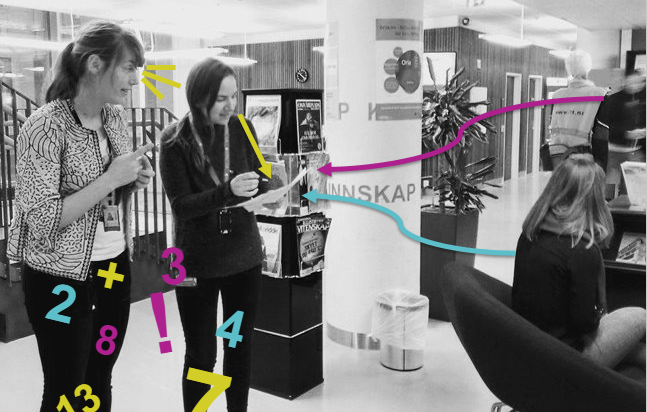This blog is the result of a collaboration by librarians at NTNU University Library in Norway: Idun Knutsdatter Østerdal, Senior Librarian; Una Ersdal, Adviser; Karen Johanne Buset, Head of Section; Astrid Kilvik, Research Librarian; Liv Inger Lamøy, Research Librarian.
Part 2 of a 2 part blog (read part 1 here)
As discussed in the prior blog, there was a lot we discovered when we began working on user experience methodologies in our libraries. But that was only part of it. Through working with UX methods, we have also learned a lot about ourselves.
The methods are still new to us, and it tales time to learn how to use them correctly and to implement measures based on the collected data. In this process, it can be easy to overlook the importance of collecting employee’s perspectives. Sure enough – during some of our previous UX projects, we lost sight of our own co-workers, who have their own library experiences.
Based on our own challenges discovering employee perspectives, we have included employee experience (EX) in our current projects. Our efforts to include our co-working have had a positive impact both for our projects and for our working environments – UX works best when it is part of everyone’s job at the library. Both the employee and the user experiences should be explored in UX projects, to enable staff to become aware of their assumptions and needs.
Keeping Both UX and EX in Mind
How you identified an area or system that has room for improvement? Do you have assumptions to test? Start by discussing the system or area with the employees working within the system. Obtaining snapshots of employee attitudes and anecdotal experiences before UX data collection may give you valuable input into the areas you need to gather data about. (And making the co-workers aware of the project’s goals is a good way of getting them involved and on-board.)
Using a combination of methods when gathering UX data, with appropriate methods, offers you more insight. However, too much data may be challenging to work through. So, give particular thought to how your combination of methods will work together to reach your aims.
Discuss and/or present findings with employees. On a small-scale project, a simple survey about their perspectives and suggestions to solutions for the current UX project will help establish project ownership among staff. It will also better their understanding of their own needs and how they might differ from our users’ needs.
Based on UX data and feedback from employees, identify solutions, preferably in collaboration with staff working within the area the project is exploring. And, finally, inform employees about chosen measures and plans for implementation.
Knowing Yourself
Knowing yourself also means knowing your library as an organization. One UX consultant, And Priestner, has developed a model to answer the question of: “Do you know your library?”

This model, “UX adoption in libraries,” can be useful when reflecting on the integration of UK in the library, at an organizational level. The factors to evaluate are culture (tradition or innovative based), infrastructure (immobility or agility), failure (fear or acceptance) and focus on library staff or library user. Where is the NTNU University Library in this model? Our work with UX is well underway, and we are headed from yellow to green in most categories. However, we still have room for improvement.
We have discovered how EX can make or break an UX project. Dividing the focus among library staff versus library users creates a partition that is unnecessarily normative and perhaps not useful in all contexts. The model places value upon UX so that a focus on a library staff would be categorized as less valuable to a development of innovation, agility, and acceptance, that is, success. In fact, we have found that it was useful for us to uncover EX (as well as UX) when developing our library.
Our key to success is knowing both ourselves and our users and their needs, and to use methods with both users and employees in mind. The UX methods make it possible to make successful changes, and evolve in tune with our users.
Each year brings new students, with different needs and expectations from our library services – library improvement is continuous work!



